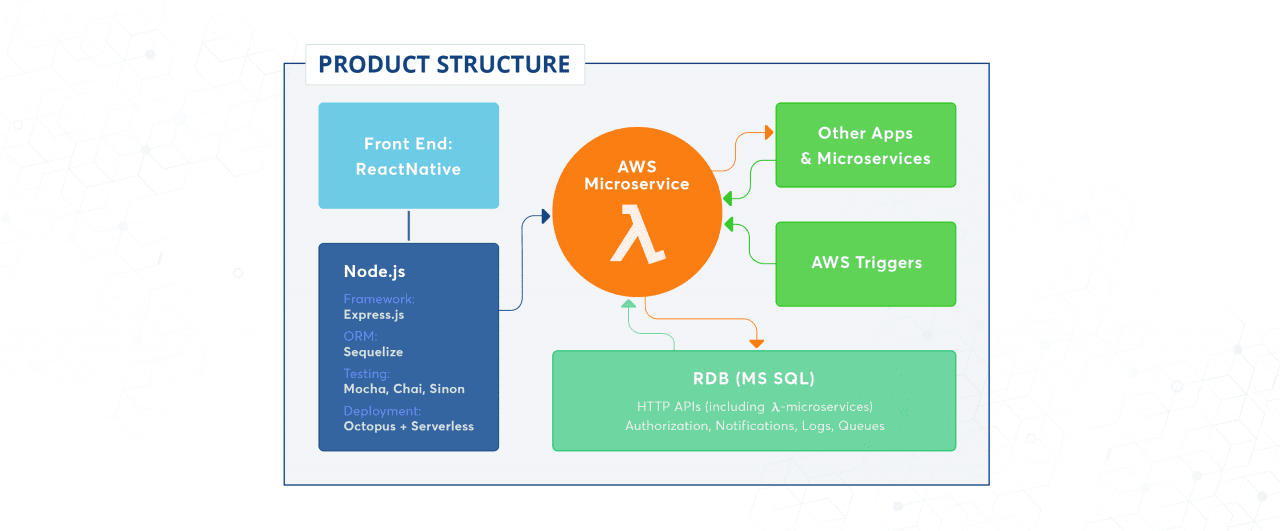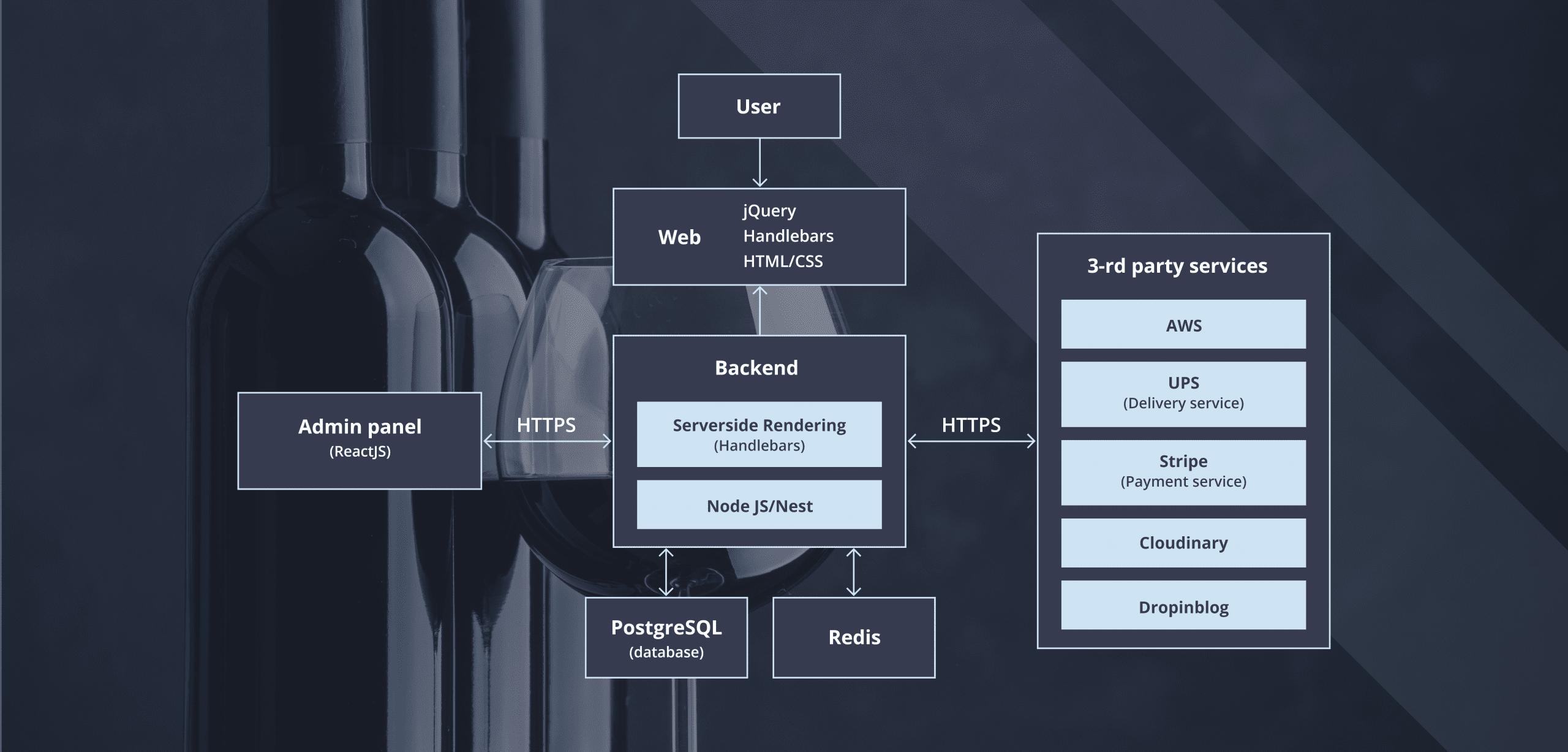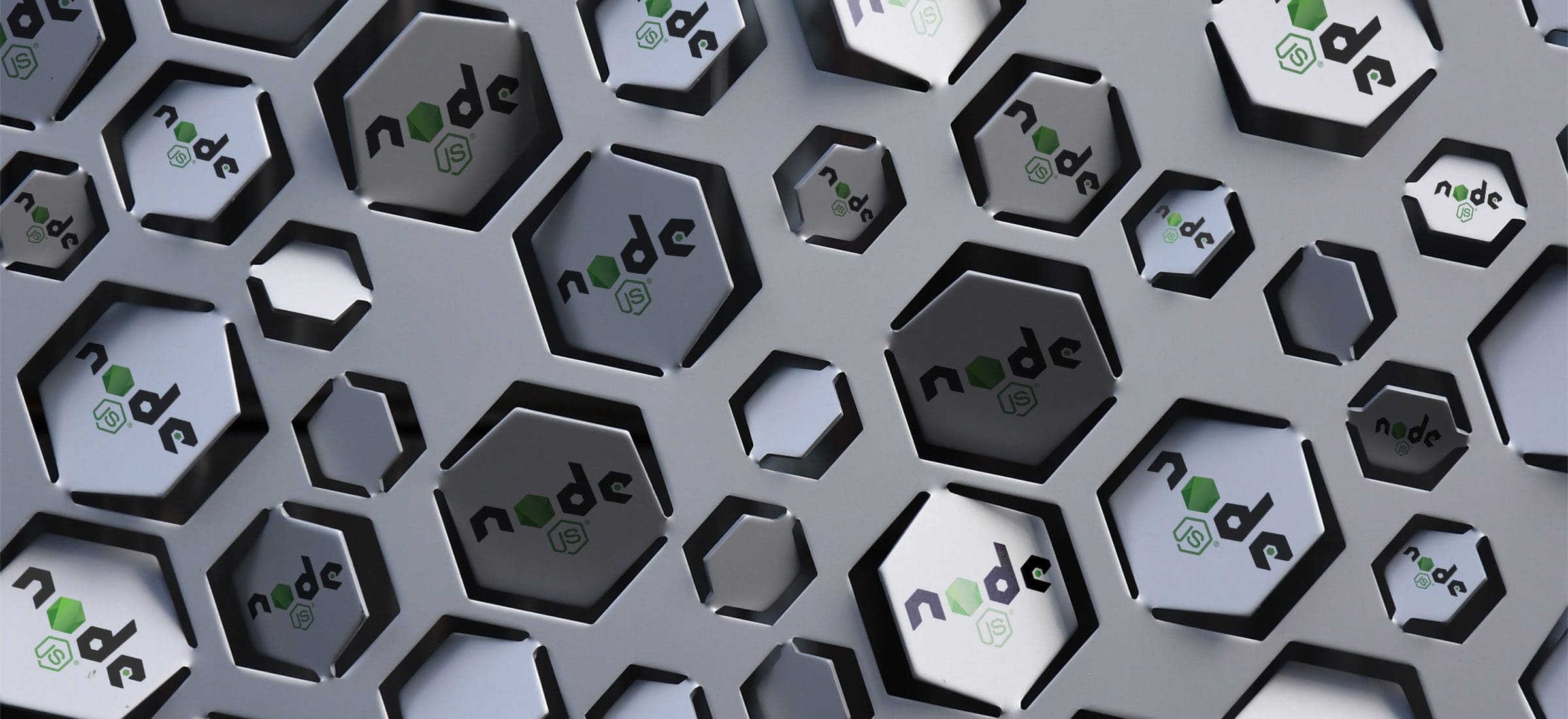It’s hard to go past the Node.js backend development option when looking for a solid server-side basis for a web project. This server environment is mostly on the shortlist when it comes to choosing a tech stack. Let’s discuss which of your IT products Node.js can become vital for.
See how we used Node.js in our case studies. Be prepared to go beyond your usual notions of the capabilities of this under-the-hood technology.
We’ll be your guides through the Node environment. And when you’re done reading this article, we’ll be ready to continue our conversation if you have a project coming up.
What Makes Node.js Technology Great?
The backend JavaScript runtime environment Node.js, having just appeared, has led to a revision of common stereotypes about the role of server-side and client-side technologies. In the pre-Node era, JavaScript was used to process data in the user’s browser. Node.js enabled the execution of JavaScript scripts on servers, sending the results of execution to users. The new platform has significantly expanded the scope of JavaScript, increasing the number of developers actively using it.
Node.js is an interesting cross-section of front-end and back-end technologies. A Node can be said to connect all elements of a web project`s tech stack.
Website development using Node.js is widespread. The number of successful examples of Node.js application development is rapidly growing. The server part of such a prominent segment as high-volume real-time apps is already quite firmly occupied by this environment. At the moment, we can state that Node.js backend development has already gone beyond the limits of exclusively web resources. Today, developers can implement all versions of your product, including desktop and mobile, with Node.js. Let’s trace the relationship between the technical and business aspects of Node.js backend development.
Five Perks of Node.js Software Development for Product Owners
Let’s summarize how the technical features of Node.js development are transformed into business benefits for software projects.
1. Node.js is a reliable base for long-term projects
The future of this back-end JS runtime environment looks promising. Just look at the results of surveys among specialists. JavaScript continues to be the most common programming language. Node.js has become one of the two most popular web technologies, which are used by more and more survey participants. The popularity of other technologies related to Node.js is also increasing. Among them there are, in particular, frameworks NestJS, Electron, Express.js, Fastify, npm package manager, runtime Deno, and so on. A large and ever-growing professional community produces new solutions for Node.js software development.
Having such a powerful resource makes Node.js development easier and faster. At the same time, Node.js has something that many other technologies do not have, namely a development strategy with a solid organizational and financial base. The Node.js Foundation, originally created alone, later merged with the JS Foundation into the new OpenJS Foundation, to which many well-known corporations contribute. Node.js is one of the ever-growing Impact Projects of this foundation with its governance structure. As you can see, Node.js is a long-term project which is advanced not only by the efforts of enthusiastic professionals but also by a special institution.
Thus, there is reason to believe that technology will continue to improve. In particular, you can expect regular long-term supported releases, elimination of Node.js vulnerabilities, etc.
So, having started your Node.js software development project, you probably won’t need to urgently look later for a replacement for this server environment.
2. Cross-platform and omnipresence
Many common technologies support Node.js. For example, such operating systems as Linux, macOS, and Microsoft Windows, and cloud vendors such as Google Cloud, Microsoft Azure, and AWS support this environment. Developers can use the server technology on mobile platforms as well. If promising technological novelties appear, the Node.js community reacts quickly by creating the necessary solutions for compatibility.
As a result, whatever technologies and tools you need in your project, you can most likely use them simultaneously with Node.js without writing additional software to connect them. Another advantage of Node.js web development is the ability to relatively easily implement functions built on this environment to other software systems. Let’s say it turned out that your project is sorely lacking in some feature, and there is, as always, not enough time to create it. With the use of Node.js, you can create the appropriate module quite quickly.
But don’t dismiss the possibility of code reusability. Perhaps you already have similar functionality in other projects. In that case, you can implement the appropriate small Node modules into the software being developed, saving time and money.
3. Rapid seamless development and cost-effective support
Of course, you remember that Node.js is not a programming language but a JavaScript runtime environment. Thus, in website development using Node.js, it is possible to use the same programming language both on the backend and frontend. Therefore, the dialogue between the developers of the server and client parts of the system becomes more meaningful and helpful, and mutual understanding becomes easier.
In addition, if you want to optimize the duration and cost of the project by inviting full-stack developers, then Node.js development is a great fit. Such features of the server environment make it possible to deal with fewer people in technical support.
A huge number of available ready-made solutions also accelerates Node.js web development.
4. High Node.js performance, speed, and scalability
Node.js operates on the powerful V8 JavaScript execution engine from Google, which is maintained and updated. In the case of Node.js web development, this means, in particular, high performance, fast streaming of data for web apps and others. Core features of the server environment also contribute to the speed of operation. After all, the Node.js server, due to asynchrony, does not wait for the data to be returned when performing various requests. In turn, non-blocking I/O ( input/output ) allows many different processes to run in parallel without interfering with each other.
Even a substantial increase in the number of concurrent requests is not critical for Node.js backend development. The absence of process blocking facilitates the development of scalable systems and allows you to cope with loads. Naturally, there are many examples of website development using Node.js with high traffic and handling millions of requests per second.
5. Saving resources during system operation
Technical features of Node.js make it possible to save software resources of the systems that were built in this environment. Here are some examples:
- Event-driven architecture. At the start of the execution of any operation, it is possible to immediately transfer the Callback function, which must be executed after the completion of this operation. Using such callback functions allows the system to use fewer server-side resources and consume less memory.
- Single-threaded operation through the Event loop. All single-threaded requests are collected in an event loop, which prevents requests from being reloaded and shortens their processing time.
- Asynchrony and non-blocking I/O allow you to handle a large number of concurrent operations using less memory and resources. The combination of all these properties of the technology makes it possible to create servers that can cope with vast loads.
We told you about the features of Node.js backend development. Next, we’ll demonstrate how we’ve used them to the benefit of our customers.
IT Products Where the Strengths of Node.js Backend Development are Most Evident
Apps and website development using Node.js give good results in various domains. An effective server side of the project helps other elements of the tech stack to reveal their potential. We’ll list the products for which Node.js is a great choice.
We will also illustrate the benefits of the technology with the help of Node.js case studies from the experience of MobiDev. With such examples, it will be easier to understand the motives that guide project teams in forming each tech stack. We will also describe situations for which Node is not suitable and advise how to act in them.
1. Lightweight, Fast Apps with Real-time Communication
The flexibility inherent in Node.js allows developers to build apps small, fast, and easily scalable. Asynchronicity, non-blocking I/O, and single-threading make Node.js application development a suitable choice when it comes to real-time information exchange. The ability to handle many concurrent connections is crucial.
If we also add the fast synchronization capabilities of this server environment, we can conclude that this combination of properties is well-suited for creating event-based apps. Such apps can, for example, use WebSockets and WebRTC.
Case Study #1. Cryptocurrency Trading Platform
Product Description:
A cryptocurrency trading app that provides traders with all the information they need to make transaction decisions and enable them to execute.
Project Challenges:
- Information processing and execution of trading operations in real-time
- Constant availability of the platform on any device
- Reduction of time-to-market and adherence to strict budget constraints
Node.js Backend Development Highlights:
1. Real-time operation of the platform
Global financial markets never sleep. The crypto-asset market is no exception to this rule. Therefore, any crypto trading platform must ensure constant reception of information, coping with a significant load.
One of the Node.js benefits is the ability to work well with WebSocket. The system constantly communicates through the WebSocket API, receiving data from external sources. Given the constant fluctuations in the exchange rates of cryptocurrencies, such platform capabilities are crucial for crypto traders, as they can buy or sell in time.
Users improve their trading techniques based on a powerful information base provided by the platform. This knowledge base is supplemented by, among other things, educational materials, analytics of exchange transactions, including detailed own transaction history, and market strategies shared by experienced crypto investors.
Other Node.js advantages that have a decisive impact on such products are its asynchronicity and non-blocking I/O. Due to these features, the platform handles many domain logic tasks at the same time, in particular, distributing requests for buying and selling cryptocurrencies and maintaining a huge number of connections.
2. Cross-platform solution
Crypto traders need to react quickly to changes in the market situation. Therefore, they cannot be tied to one device. That’s why the platform has a mobile version implemented using Flutter in addition to the web app. With this approach, there is no need to build apps separately for iOS and Android. That is, we reduced the development time. In turn, our specialists have once again confirmed that Node.js is a reliable backend for both web and mobile applications.
3. Shortening the time-to-market and compliance with strict budget restrictions
We selected the tech stack and product configuration based on the priorities set by the client, among which were the rapid introduction of the platform to the market and cost savings during development. Here’s what we managed to come up with:
- Node.js was the backbone of the project’s tech stack. The developers of the client part (React JS) and server part used the same programming language, which also helped to speed things up.
- Considering the challenges of the project, together with the stakeholders, we refused to build a crypto platform completely from scratch. Our project team members suggested getting the most out of the integration of advanced third-party solutions.
In this situation, Node.js fully lived up to its name, becoming, as the single backend of the system, the place where all its elements are connected.
As a result, some essential features of the software were implemented through integrations, in particular:
- – security with Jumio
- – access to the cryptocurrency exchange via API integration with Kraken
- – support and other customer communications via Zendesk.
Features of the Node.js case study:
- asynchronicity and non-blocking I/O
- fast, seamless development
The usage of Node.js provides true cross-platform compatibility and promotes smooth development. While working on a cryptocurrency trading system, the backend developer could always suggest something to a colleague who codes the front end and mutually count on a helpful tip. Internal communications are easier in a project with Node.js on the backend and JavaScript on the client side. It reduces the time to build software.
2. Node.js with Serverless and Microservice Architecture
Node.js works well with such common design styles as serverless and microservices. Serverless architecture owes its popularity to the ability to reduce computing costs by flexibly consuming resources exactly in the required volumes. It is also considerable that the provider of serverless service manages the infrastructure.
As a rule, serverless apps are stateless and lightweight, and Node.js shows itself perfectly in this category. Npm has many packages for serverless systems. Also, Node.js software development is a good match for overall microservice architecture, in particular, in cases of volatile server load.
Case Study #2. Cross-Platform System for Energy Consumption Management
Product Description:
A system of websites and a cross-platform (iOS and Android) app for monitoring, predicting and optimizing energy consumption by users.
Project Challenges:
- Automatic system scaling and reliable uninterrupted operation under high load
- Introducing new products to the client’s existing ecosystem
Node.js Backend Development Highlights:
1. Serverless for autoscaling
The customer of this project is an energy retail company that has been operating for over 20 years. The client base exceeds 1.5+ Million consumers. All of them are a potential user audience of the energy consumption management system being created. Therefore, the need for automatic scaling and operation under a high load was very urgent.
The responses to such project calls were based on serverless and Node.js development for the system backend. Cloud serverless computing service AWS Lambda, which supports Node.js, was also chosen. In this way, it was possible to ensure smooth uninterrupted operation under a high load and autoscaling.
2. Supplementing the customer’s working ecosystem
The client is an established company with relevant IT systems that needed to be supplemented with new elements so smoothly that it would not affect their current work. Working together with the client’s in-house teams, our developers prepared an automated product deployment for six different environments. A set of websites was developed for each of the markets in which the client is represented. Data and processes from web resources are synchronized with the cross-platform mobile app. In this way, users have a seamless interaction with the energy provider, changing channels but maintaining access to transaction history and other data.
Features of the Node.js case study:
- Event-driven architecture for Serverless
- Asynchronicity and non-blocking I/O
- Backend for websites and cross-platform mobile apps.
You can see the structure of the product created using Node.js backend development in the image.

3. Node.js Backend Development for Internet of Things (IoT) Solutions
If the Internet of Things (IoT) system is implemented on many devices, then this makes special requirements for the server environment. It is necessary to deal with a large number of messages with data coming from sensors. Node.js is probably the best choice in such cases, because it handles many simultaneous requests quickly.
Case Study #3. Draft Beverage Management Platform for Bars and Restaurants
Product Description:
The BarTrack platform is used for providing venues (breweries, restaurants, and bars) with real-time information about the beverage, including the order system, inventory level, and storage parameters.
Project Challenges:
- Implementation of IoT solutions
- Integration with the venue’s Point of Sale systems
- Real-time receipt and visualization of information for each user and the ability to scale the system
Node.js Backend Development Highlights:
1. We created a fully integrated IoT solution
Node.js is well suited for IoT. The non-intrusive beverage sensor measures the volume and storage parameters of the beverage in each container in each of the connected venues and transmits the data to the system.
2. Our specialists carried out the integration with the users’ Point of Sale systems
In this way, it was possible to create detailed analytics that compare accounting and actual data and are displayed on TV screens in the venues.
We have developed Extract, Transform, and Load (ETL) processes for data analyzed by the system. As a result, users can monitor inventory levels, sales volumes and losses, and compliance with storage conditions for each of the beverages in real time. By tracking their KPIs, managers understand in time whether the situation requires intervention and what it should be.
3. The platform is real-time and scalable
New venues are constantly being added to the system. Therefore, the ability to scale is as crucial as the transmission and processing of data in real-time mode.
We decided to go the serverless route, which made it possible to flexibly use resources under high loads, guarantee scalability and fail-safe operation. The serverless approach is well-proven at high loads due to automatic scaling and management of external interactions.
Node.js scalability support has considerable potential. Node.js architecture is event-driven. Serverless cloud services invoke based on certain triggers and events. Therefore, Node.js functions well in serverless solutions. Leading cloud providers of serverless computing services, such as Google Cloud Functions, Azure Functions, and AWS Lambda, support this environment.
Node.js is the core element of such parts of the BarTrack platform as the Main Server, Analytics app, PoS Integration app, etc. As a result, the system successfully copes with high real-time loads, scaling automatically and providing data to users without interruption.
Features of the Node.js case study:
- Event-driven architecture for Serverless
- Asynchronicity and non-blocking I/O
- Backend for IoT solutions.
4. Node.js for Streaming Audio and Video
The combination with external media tools allows Node.js to be a reliable option for transferring and processing multimedia data. Data streaming can be easily configured using asynchronous input and output. That is why Node.js backend development is often used when building streaming entertainment platforms. Additionally, Node.js has its streaming API.
Case Study #4. Cloud Platform for Group Therapy and Wellness
Product Description:
GroupWell is a cloud-based HIPAA-compliant service that allows people with behavioral disorders to access the care of licensed therapists and certified coaches in behavioral and treatment groups.
Project Challenges:
- Quality and glitch-free data streaming during group video sessions
- Compliance with HIPAA requirements
- Implementation of the logic of the healthcare domain, which is characterized by high requirements
- The need to reduce the cost of development.
Node.js Backend Development Highlights:
1. Data streaming, which allows group remote meetings
Our developers have ensured high-quality data streaming during group work sessions conducted by coaches and therapists via video communication. The web service copes with the load even with a significant number of simultaneous video conferences.
2. HIPAA compliance
Compliance with HIPAA standards was one of the key requirements in this example of Node.js web development. Adhering to this condition, in particular, during the development, our specialists paid special attention to the processing and protection of users’ data.
3. Implementing complex business logic for group therapy and wellness
To create the domain logic relevant to the project task, our software engineers provided, among other things, the following:
- Document circulation by users and groups with personal data security
- A comprehensive system for tracking the user’s behavioral health symptoms, which includes measurement, monitoring, and analytics
- Selection of the most matched groups and specialists individually for each therapy participant
- Planning tools, including calendars, schedules, etc.
4. Integrations to speed development and reduce project costs
A flexible approach was used when building the web system, in which the development of unique business logic elements was combined with reliance on specialized third-party services. The duration and cost of development were reduced, in particular, through integration with a calendar (Google Calendar), a payment system (Stripe), video chat and UX (Ant Design), etc.
GroupWell is an example of website development using Node.js, where users access the system even from mobile devices through the site. This turned out to be enough for the platform`s successful operation. That`s why the task of creating mobile apps was not.
Features of the Node.js case study:
- HIPAA compliance, including regarding security
- Implemented sophisticated logic for the mental health domain
- Fast and high-quality data streaming
This started out as a small, demo project that blossomed into a full-scale application due to the dedication, commitment, and teamwork from MobiDev. The team is smart, capable, and very strong communicators. They find a way around every technical challenge we face. I don’t think of them as outsourced, but instead as my team.
Let's get in touch!
Contact us
5. Projects Requiring Rapid Development
Node.js is based on the most common programming language, so it stands out for its ease of understanding and application. The use of a common syntax by backend and frontend programmers facilitates intra-team communication, speeds up creation, and facilitates further code maintenance. The seamlessness inherent in Node.js web development allows project teams to minimize ramp-up times. From the experience of MobiDev specialists, Node.js in the project stack, where JavaScript is used on the client side, allows us to reduce the development duration by 15-20%. In the case studies below, you will see how, with the help of Node.js, we brought new products to market without delays.
Case Study #5. Online Workplace Development for Damage Repair Professionals
Product Description:
Sublink is an online marketplace where customers find hail-damage car repair service providers.
Project Challenges:
- High performance and stability of the system under high loads in real time
- Cross-platform and lack of any barriers for users to access the marketplace
- Short development times due to the need to launch the platform before the start of the season
Node.js Backend Development Highlights:
1. A full-fledged workspace with detailed documentation
The platform connects customers and car repair service providers. But it was also necessary to create a documentary basis for transactions. It’s fair to think of Sublink as a kind of niche Upwork, but the relationship between customers and mechanics is much more regulated here.
After all, most orders on the online marketplace are related to insurance claims. It is well known that insurance companies are picky about the cost of repairs and paperwork.
Thus, the platform copes in real-time properly with a large flow of data in various formats due to asynchrony and I/O inherent in Node.js development. Repair shop workloads and order flow change rapidly, so constant data updates are essential.
2. Permanent convenient user access
For constant unhindered access of users to the system, we have created a web portal and two mobile apps – for iOS and Android. We performed Node.js backend development for all apps through which customers and repairers use the marketplace. Real-time chat, powered by Socket.IO on the web portal, and native iOS and Android apps, facilitates interaction between all parties.
3. Fast Node.js development is the key to a successful platform launch
A stitch in time saves nine. The marketplace had to be tested and launched before the start of the season when hail is common and demand for hail repair services is high.
We met the set deadline, and the Node.js stack helped us with this too. In addition to Node.js backend development, our developers used the JavaScript library Nuxt.js with an isomorphic approach, which also contributed to the reduction of development time.
Features of the Node.js case study:
- Asynchronicity and non-blocking I/O
- Fast, seamless development
The technological solutions of the project, including Node.js application development, are visualized below.

Natalia is by far the best project manager we have ever worked with. Her communication and quality of work reduced stress levels by 90% on our end. She owned our project like it was her brainchild and protected its integrity like she was a stakeholder. Awesome job! Can’t wait for the next opportunity that brings us together.
Let's discuss your project!
Contact usCase Study #6. SAAS Platform for Winery Industry in Europe
Product Description:
WineJump is a marketplace where wineries sell their products directly, without intermediaries.
Project Challenges:
- High loads in real-time
- Complex and diverse domain logic
- Integration of third-party solutions that ensure the full cycle of product purchase
- The brevity of the development terms and the vital criticality of the first release for the project’s continuation.
Node.js Backend Development Highlights:
1. The platform that withstands high loads
The system is large, with over 1,500 wineries joining it. The number of visitors who are interested in buying is also very significant. A marketplace is unthinkable without real-time. Our developers relied on such capabilities of Node.js web development as asynchrony, non-blocking I/O calls, and single-thread processing of requests that are collected in the Event loop. The platform seamlessly supports many concurrent connections through which users receive information and perform operations.
2. The project team implemented the complex business logic of the international online marketplace
The creation of the platform’s domain logic required the solution of many diverse issues. The marketplace covers nine countries, and most transactions are international. For such a web resource, it is essential to take into account the legislation of both the European Union and each of the countries of origin of the products.
Taxation has many peculiarities in each European state. Delivery routes for purchased products also vary in length and complexity. Besides wine, the marketplace also sells olive oil and other agricultural products.
Through Node.js web development, it was possible to implement the domain logic that ensures the operation of the international marketplace. Now, when the user connects to the platform, he gets to exactly the segment that corresponds to the country where the winery is located. MobiDev developers built the functionality of automated price calculation, already taking into account taxes, customs duties, and delivery costs. The system automatically creates a package of documents for each order in the seller’s account, under the legal norms of the EU and the country selected by the user, as well as delivery options. Thus, the buyer, having chosen a product, immediately learns about its final price for each of the nine countries of delivery and consciously makes a decision to purchase. Execution of transactions concluded on the marketplace is a combination of developed features of the system and integration of third-party solutions.
The highlight of the platform is the functionality created for not only online but also offline purchases. With the Sales Point Scan & Shop, visitors to wineries can place orders directly during tours. Such an order is also entered into the platform, and when the visitors return home, they will already be waiting for the deliveries provided by the marketplace.
3. Integration of third-party solutions for the complete purchase cycle
The platform has automated all stages of interaction with the shopper, from the first acquaintance with the product, to its delivery. In addition to the autonomous development of the necessary features, integrations with relevant third-party solutions were carried out. In particular, our developers have introduced the possibility of using the services of such providers as:
- Stripe – for payments
- UPS for delivery.
4. Rapid development, which is crucial for a startup
Accelerated preparation of the first phase release was the objective of the customer. There were no off-the-shelf solutions with all the necessary functionality. There was only one way out – the selection of the optimal technical stack and rapid seamless development based on it. We achieved the goal by creating MVP 1st stage in 1.5 months. Ultimately, the startup grew into a powerful niche marketplace.
Features of the Node.js case study:
- Asynchronicity and non-blocking I/O
- Complex advanced domain logic
- Fast, seamless development
Schematically, the platform structure is shown in the image.

We needed in 2019 to transform a brilliant idea to an early viable product we could bring to market. As a young startup, we did not have the resources to set up an in-house backend and frontend team. MobiDev was a great match for us – and still is. As we mature our startup we keep working with MobiDev, enjoying the flexibility of being able to deploy sprint development as needed. The tech has proved lean, resilient, and scalable. A big thanks to all MobiDev’ers in our team!
Tell us about your project
Contact us
Cases Where the Node.js Advantages Do Not Apply
It is not possible to satisfy all domains and all types of websites and applications with the same technology. The server environment we are talking about is no exception. So, let’s see the products for which Node.js software development is not very suitable:
- Financial software
The specifics of working with a floating decimal point can lead to the accumulation of errors in variables. This is unacceptable in finance. Tools for creating logic with high-precision calculations exist, of course. But they need to be used with care, given the intricacies. Perhaps it makes sense to take a closer look at alternative technologies. Our own good example of a financial management solution is based on Ruby.
- Programs with complex CPU calculations
Heavy requests are processed slowly and become causes of general delays in the event loop. Therefore, Node.js is not an optimal option for highly loaded threads that involve the CPU.
Should you immediately give up on Node.js web development if your project requires complex processor or financial calculations? The answer to this question is more sophisticated than it might seem at first glance.
First, Node.js is gradually closing its capability gaps. For example, a function called worker threads facilitates solving some CPU-bound tasks.
Second, a lot depends on the specifics of the system you want to create. Sometimes the issue can be solved through the integration of third-party solutions, for which Node.js backend development fits very well. Often, a microservice architecture allows you to implement a financial calculation module built with another technology into the system.
There are so many subtleties in selecting the tech stack for a software project that it is impractical for the product owner to do it alone. When preparing each project, there comes a moment when nothing can replace expert advice. This is because, more important than technologies, are people who know how to use them correctly.
Let’s Start Building Your Product Together!
In this article, we have shared only a small part of our experience as a Node.js development company. We implemented projects of various scales in the Node environment, from a startup, to a highly loaded enterprise system.
Get in touch, explain your product’s vision, and we will help you choose the right technological basis for it. If we jointly see the need for Node.js, you can be sure that your software will get the most out of it. Contact us! It’s time to launch your Node.js development project!








